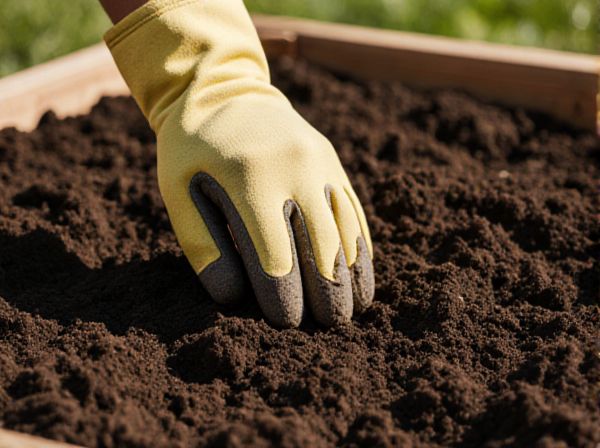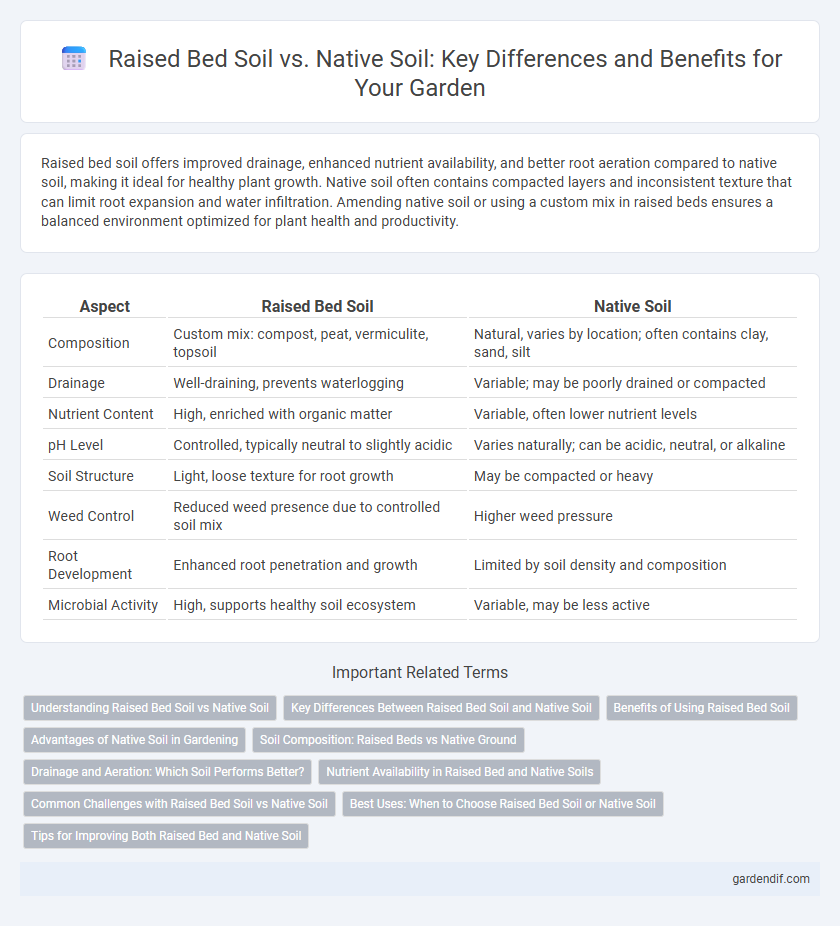
Raised Bed Soil vs Native Soil Illustration
Raised bed soil offers improved drainage, enhanced nutrient availability, and better root aeration compared to native soil, making it ideal for healthy plant growth. Native soil often contains compacted layers and inconsistent texture that can limit root expansion and water infiltration. Amending native soil or using a custom mix in raised beds ensures a balanced environment optimized for plant health and productivity.
Table of Comparison
| Aspect | Raised Bed Soil | Native Soil |
|---|---|---|
| Composition | Custom mix: compost, peat, vermiculite, topsoil | Natural, varies by location; often contains clay, sand, silt |
| Drainage | Well-draining, prevents waterlogging | Variable; may be poorly drained or compacted |
| Nutrient Content | High, enriched with organic matter | Variable, often lower nutrient levels |
| pH Level | Controlled, typically neutral to slightly acidic | Varies naturally; can be acidic, neutral, or alkaline |
| Soil Structure | Light, loose texture for root growth | May be compacted or heavy |
| Weed Control | Reduced weed presence due to controlled soil mix | Higher weed pressure |
| Root Development | Enhanced root penetration and growth | Limited by soil density and composition |
| Microbial Activity | High, supports healthy soil ecosystem | Variable, may be less active |
Understanding Raised Bed Soil vs Native Soil
Raised bed soil typically contains a balanced mix of organic matter, compost, and well-draining components, promoting better aeration and root growth compared to native soil, which often varies in texture and nutrient content based on location. Native soil may be compacted or deficient in essential nutrients, impacting plant health, while raised bed soil is engineered to provide optimal conditions for water retention and microbial activity. Understanding these differences helps gardeners improve plant productivity and soil structure by tailoring amendments to native soil or selecting quality raised bed mixes.
Key Differences Between Raised Bed Soil and Native Soil
Raised bed soil is typically looser, richer in organic matter, and better drained than native soil, promoting faster root growth and higher crop yields. Native soil often has a more compact structure with varying pH levels and nutrient deficiencies that can limit plant health. Using raised bed soil allows gardeners to control soil composition, texture, and moisture retention, overcoming many limitations of native soil conditions.
Benefits of Using Raised Bed Soil
Raised bed soil enhances drainage and aeration, promoting healthier root development compared to native soil. It is typically enriched with organic matter and nutrients, resulting in improved fertility and higher crop yields. The controlled environment minimizes soil compaction and pest issues, optimizing plant growth and resilience.
Advantages of Native Soil in Gardening
Native soil offers superior microbial activity and natural nutrient cycling compared to raised bed soil, promoting healthier plant growth and sustainability. Its inherent structure supports better water retention and root development, reducing the need for frequent irrigation. Utilizing native soil preserves local ecosystems and reduces environmental impact by minimizing soil transport and amendments.
Soil Composition: Raised Beds vs Native Ground
Raised bed soil typically contains a tailored blend of organic matter, compost, and well-draining materials such as peat moss and vermiculite, enhancing nutrient availability and aeration. In contrast, native soil varies widely but often includes clay, silt, and sand in proportions that can limit drainage and root penetration. Optimized raised bed soil composition supports healthier plant growth by providing a controlled environment that native ground soil may lack due to its natural density and compaction.
Drainage and Aeration: Which Soil Performs Better?
Raised bed soil typically offers superior drainage and aeration compared to native soil due to its loose, well-amended composition often rich in organic matter and sand. Native soil may suffer from compaction and poor structure, leading to water retention issues and limited oxygen availability for roots. Enhanced drainage and aeration in raised beds promote healthier root systems and increased plant growth potential.
Nutrient Availability in Raised Bed and Native Soils
Raised bed soil typically offers enhanced nutrient availability due to its controlled composition, often enriched with organic matter and balanced fertilizers tailored to plant needs. Native soil varies widely in nutrient content and may lack essential elements or suffer from poor structure, limiting nutrient uptake by plants. Optimizing nutrient availability in raised beds supports healthier root development and higher crop yields compared to many native soils.
Common Challenges with Raised Bed Soil vs Native Soil
Raised bed soil often faces challenges such as poor nutrient retention and excessive drainage compared to native soil, which naturally balances moisture and fertility. Compaction can be less of an issue in raised beds but may lead to uneven root development if soil mix is improperly formulated. Native soil's microbial diversity typically supports plant health better, while raised beds require careful management of organic matter and amendments to mimic this ecosystem.
Best Uses: When to Choose Raised Bed Soil or Native Soil
Raised bed soil is ideal for controlled gardening environments, offering improved drainage, aeration, and nutrient-rich composition suitable for vegetables, herbs, and flowers requiring precise soil conditions. Native soil is best suited for established landscaping projects, native plant growth, and large-scale outdoor areas where natural soil ecosystems support local flora and provide stability. Choosing between raised bed soil and native soil depends on the crop type, soil quality needs, and the gardener's goal for soil modification or preservation.
Tips for Improving Both Raised Bed and Native Soil
To enhance raised bed soil, incorporate organic matter such as compost, aged manure, and well-rotted leaves to boost nutrient content, water retention, and soil structure. For native soil, conduct a soil test to determine pH and nutrient deficiencies, then amend with lime, sulfur, or fertilizers accordingly while incorporating organic materials to improve aeration and microbial activity. Regularly mulching both soil types helps conserve moisture, suppress weeds, and maintain consistent soil temperature.
Raised Bed Soil vs Native Soil Infographic

 gardendif.com
gardendif.com